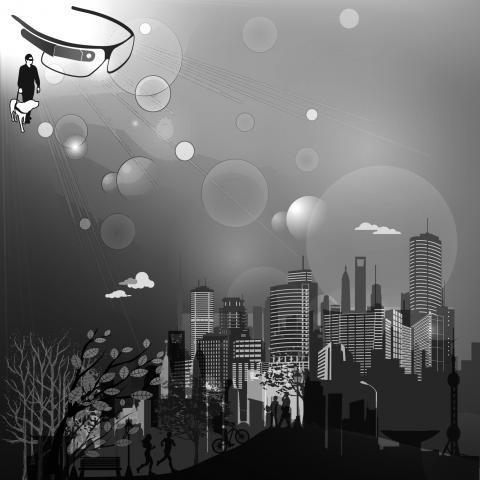Absent what he calls “super luck,” Stephen Hicks could easily have found himself lugging plasma TV screens up the staircases of apartment buildings. As it turned out, the Australian scientist, who was in need of money in 2007, landed a job that was the first step in the creation of elaborate “smart glasses.”
The claim for the smart glasses is that they have the potential of giving those with impaired sight the chance to recognize everyday objects and people again.
The glasses use a combination of cameras to sense objects such as tables and walls, as well as people, and then process that information into bright light on a screen. The person with impaired sight can use what is left of their vision to understand what is in front of them and navigate their surroundings.

Illustration: Tania Chou
Hicks and his colleagues in Oxford recently won a £500,000 (US$816,000) grant to expand the project and they now plan to create 100 pairs of the glasses to test on people with sight loss, in their homes. They aim to bring smart glasses to market at the end of next year.
It is the culmination of a life-long interest in neuroscience for Hicks, who was led back to his passion for investigating how technology and the brain can work together when researching Huntington’s disease about seven years ago.
The latest prototype of his work uses two cameras and a laser to identify objects and then relay that information to a computer, which displays the objects on the glasses in very simplified form — detailed bright shapes. Users can see the objects using their residual vision, which typically is limited to perceptions of light and motion.
In effect, the wearer sees a reduced version of the world without color, where objects that are closer are much brighter. When people, bus stops and cars are farther away they get darker.
When he began the research, Hicks found that most people classified as blind still had some vision. “I didn’t realize that blindness was this continuum. In hindsight, of course it is, it is the same as deafness: You can get people who are profoundly deaf, but the majority of people who are using hearing aids really just need [sound] amplified.”
The technology is aimed at allowing those with partial sight to navigate around the environment with much greater ease.
In one of the early tests, a man was able to see his guide dog for the first time.
“A guy had seen his guide dog and said, ‘There you are, girl.’ Then we saw the power of what this could potentially mean to someone when it becomes more generally used,” Hicks said.
Some light perception is needed; the glasses can be calibrated to sensitivity.
“Nearby things are going to get brighter, so put your hand in front and wave it and you will see it. You will be able to build up hand-eye coordination. You will be able to walk around unfamiliar environments, especially at nighttime and get a good idea about obstacles — where gutters are, where overhanging branches are — giving you confidence to walk down unfamiliar streets and be able to avoid bollards and buggies,” Hicks said.
Lyn Oliver, 70, from Faringdon, Oxfordshire, has joined the trials. She says she can see bone structures from almost 2m away, as well as ceiling beams and doorways. She became unable to read print in 1970 and started using a guide dog three years later.
“It will be less stress,” she said. “Because I live in a market town, there is walking into hedges and low branches and things parked over the path. It will make a lot of difference to a lot of people and give them that little bit of normality, the confidence of walking out.”
Hicks quotes figures from the Royal National Institute of Blind People (RNIB) that reveal that less than half of people who were severely sight-impaired tended to leave their home on any one day because of the dangers of running into objects.
The RNIB has been working with Hicks and Oxford University to develop the glasses.
“We are excited about the potential these glasses have to improve the way blind and partially sighted people go about their everyday lives,” the RNIB’s Neil Heslop said.
The glasses have gotten smaller since initial tests that involved augmented ski goggles with banks of screens, but they are still chunky and pronounced. The makers aim to slim them down further until they are as unobtrusive as possible, with the potential of retrofitting normal glasses with the technology.
The funding for the project came from the Google Impact Challenge, a scheme to fund charities using technology to aid people. The glasses being developed are to be tested at home by 1,000 people. A spinoff company owned by the RNIB, Oxford University and the device creators is planned.
Hicks aims to have the first sets of glasses for sale by the end of next year, priced between £300 and £400, but said they would not immediately eradicate the need for such aids as canes.
“It is more important for me to have lots of these in people’s hands rather than a few for people who can afford it. If you can do mobile phones for that kind of price, I don’t see why we can’t replicate that with our own commercial approach,” he said.
There are more than 2 million people in the UK with impaired vision and 300,000 people are registered blind, the RNIB said.

Taiwan has lost Trump. Or so a former State Department official and lobbyist would have us believe. Writing for online outlet Domino Theory in an article titled “How Taiwan lost Trump,” Christian Whiton provides a litany of reasons that the William Lai (賴清德) and Donald Trump administrations have supposedly fallen out — and it’s all Lai’s fault. Although many of Whiton’s claims are misleading or ill-informed, the article is helpfully, if unintentionally, revealing of a key aspect of the MAGA worldview. Whiton complains of the ruling Democratic Progressive Party’s “inability to understand and relate to the New Right in America.” Many
The Centers for Disease Control and Prevention (CDC) earlier this month raised its travel alert for China’s Guangdong Province to Level 2 “Alert,” advising travelers to take enhanced precautions amid a chikungunya outbreak in the region. More than 8,000 cases have been reported in the province since June. Chikungunya is caused by the chikungunya virus and transmitted to humans through bites from infected mosquitoes, most commonly Aedes aegypti and Aedes albopictus. These species thrive in warm, humid climates and are also major vectors for dengue, Zika and yellow fever. The disease is characterized by high fever and severe, often incapacitating joint pain.
In nature, there is a group of insects known as parasitoid wasps. Their reproductive process differs entirely from that of ordinary wasps — the female lays her eggs inside or on the bodies of other insects, and, once hatched, the larvae feed on the host’s body. The larvae do not kill the host insect immediately; instead, they carefully avoid vital organs, allowing the host to stay alive until the larvae are fully mature. That living reservoir strategy ensures a stable and fresh source of nutrients for the larvae as they grow. However, the host’s death becomes only a matter of time. The resemblance
Most countries are commemorating the 80th anniversary of the end of World War II with condemnations of militarism and imperialism, and commemoration of the global catastrophe wrought by the war. On the other hand, China is to hold a military parade. According to China’s state-run Xinhua news agency, Beijing is conducting the military parade in Tiananmen Square on Sept. 3 to “mark the 80th anniversary of the end of World War II and the victory of the Chinese People’s War of Resistance Against Japanese Aggression.” However, during World War II, the People’s Republic of China (PRC) had not yet been established. It